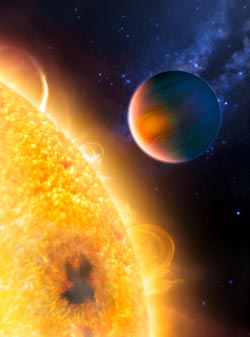Hubble finds first organic molecule on extrasolar planet

Artist’s impression of the extrasolar planet HD 189733b, now known to have methane and water. Astronomers used the Hubble Space Telescope to detect methane — the first organic molecule found on an extrasolar planet. Hubble also confirmed the presence of water vapour in the Jupiter-size planet’s atmosphere, a discovery made in 2007 with the help of the Spitzer Space Telescope. They made the finding by studying how light from the host star filters through the planet’s atmosphere.<br>
Under the right circumstances methane can play a key role in prebiotic chemistry – the chemical reactions considered necessary to form life as we know it. Although methane has been detected on most of the planets in our Solar System, this is the first time any organic molecule has been detected on a world orbiting another star.
This discovery proves that Hubble and upcoming space missions, such as the NASA/ESA/CSA James Webb Space Telescope, can detect organic molecules on planets around other stars by using spectroscopy, which splits light into its components to reveal the “fingerprints” of various chemicals.
“This is a crucial stepping stone to eventually characterising prebiotic molecules on planets where life could exist”, said Mark Swain of NASA’s Jet Propulsion Laboratory (JPL), Pasadena, USA, who led the team that made the discovery. Swain is lead author of a paper in the 20 March issue of Nature.
The discovery comes after extensive observations made in May 2007 with Hubble’s Near Infrared Camera and Multi-Object Spectrometer (NICMOS). It also confirms the existence of water molecules in the planet’s atmosphere, a discovery made originally by NASA’s Spitzer Space Telescope in 2007. “With this observation there is no question whether there is water or not – water is present”, said Swain.
The planet, HD 189733b, now known to have methane and water vapour is located 63 light-years away in the constellation Vulpecula, the little fox. HD 189733b, a “hot Jupiter”-type extrasolar planet, is so close to its parent star that it takes just over two days to complete an orbit. “Hot Jupiters” are the size of Jupiter but orbit closer to their stars than the tiny innermost planet Mercury in our Solar System. HD 189733b’s atmosphere swelters at 900 degrees C, about the same temperature as the melting point of silver.
The observations were made as the planet HD 189733b passed in front of its parent star in what astronomers call a transit. As the light from the star passed briefly through the atmosphere along the edge of the planet, the gases in the atmosphere imprinted their unique signatures on the starlight from the star HD 189733. According to co-author Giovanna Tinetti from the University College London and the European Space Agency: “Water alone could not explain all the spectral features observed. The additional contribution of methane is necessary to fit the Hubble data”.
Methane, composed of carbon and hydrogen, is one of the main components of natural gas, a petroleum product. On Earth, methane is produced by a variety of sources: natural sources such as termites, the oceans and wetland environments, but also from livestock and manmade sources like waste landfills and as a by-product of energy generation. Tinetti is however quick to rule out any biological origin of the methane found on HD 189733b. “The planet’s atmosphere is far too hot for even the hardiest life to survive — at least the kind of life we know from Earth. It’s highly unlikely that cows could survive here!”
The astronomers were surprised to find that the planet has more methane than predicted by conventional models for “hot Jupiters”. This type of hot planet should have much more carbon monoxide than methane but HD 189733b doesn’t. Tinetti explains: “A sensible explanation is that the Hubble observations were more sensitive to the dark night side of this planet where the atmosphere is slightly colder and the photochemical mechanisms responsible for methane destruction are less efficient than on the day side”.
Though the star-hugger planet is too hot for life as we know it, “this observation is proof that spectroscopy can eventually be done on a cooler and potentially habitable Earth-sized planet orbiting a dimmer red dwarf-type star”, Swain said. The ultimate goal of studies like these is to identify prebiotic molecules in the atmospheres of planets in the “habitable zones” around other stars, where temperatures are right for water to remain liquid rather than freeze or evaporate away.
“These measurements are an important step to our ultimate goal of determining the conditions, such as temperature, pressure, winds, clouds, etc., and the chemistry on planets where life could exist. Infrared spectroscopy is really the key to these studies because it is best matched to detecting molecules”, said Swain.
Media Contact
More Information:
http://www.spacetelescope.org/news/html/heic0807.htmlAll latest news from the category: Physics and Astronomy
This area deals with the fundamental laws and building blocks of nature and how they interact, the properties and the behavior of matter, and research into space and time and their structures.
innovations-report provides in-depth reports and articles on subjects such as astrophysics, laser technologies, nuclear, quantum, particle and solid-state physics, nanotechnologies, planetary research and findings (Mars, Venus) and developments related to the Hubble Telescope.
Newest articles

Silicon Carbide Innovation Alliance to drive industrial-scale semiconductor work
Known for its ability to withstand extreme environments and high voltages, silicon carbide (SiC) is a semiconducting material made up of silicon and carbon atoms arranged into crystals that is…

New SPECT/CT technique shows impressive biomarker identification
…offers increased access for prostate cancer patients. A novel SPECT/CT acquisition method can accurately detect radiopharmaceutical biodistribution in a convenient manner for prostate cancer patients, opening the door for more…

How 3D printers can give robots a soft touch
Soft skin coverings and touch sensors have emerged as a promising feature for robots that are both safer and more intuitive for human interaction, but they are expensive and difficult…





















